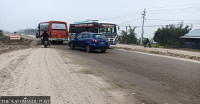National
Despite tremendous growth in the digital payment system, potential remains huge, insiders say
Cashless transactions are popular among small businesses to large enterprises. But digital literacy, digital divide and trust remain as major challenges, they say.
Krishana Prasain
Nabin Budhathoki, who runs a grocery store in Kirtipur, had never thought that he would one day sell goods via the “scan and pay” system when he had heard about the digital payment mode a few years ago.
But 25 years after he started his business, Budhathoki adopted the digital payment mode last October. He now has a quick response code (QR code), a rectangular plastic payment display plate at his shop. The two-dimensional code is made up of black and white squares that can be read by smartphone cameras.
When asked why he started using the system, he said, “This system is easy and interesting too.”
Budhathoki, 44, had initially been hesitant to use the new system, but when a number of customers started inquiring about it, he went to the bank to find out more about digital payment.
With the Covid-19 pandemic at its peak in the country in October, his adoption of the system just before the Dashain festival came at an opportune time.
Paying digitally has become convenient not only for businesses, but also for customers.
Bidya Kunwar, a resident of Chobhar, has one unforgettable memory to recall.
During the lockdown last year, she forgot to carry her wallet while going shopping. But thanks to the burgeoning digital payment system which has reached even small grocery shops, she did not have any problem making her purchases.
“Though I have been using debit and credit cards for a long time, I used to carry cash to make small payments to buy vegetables, fruits or groceries,” said Kunwar, 29, who works in a private corporate office.
“Now, there are QR payment systems everywhere that enable you to make even small payments,” she said. “That’s why it is gaining traction.”
The QR code, first invented for the automotive industry in Japan, was patented by Toyota subsidiary Denso Wave in 1994.
According to reports, while QR codes have been used for payments at Starbucks and other retailers for nearly a decade, they began to be used much more for payments when WeChat and Alipay in China started offering proprietary versions in late 2011.
While it took some time for QR code payments to become popular in China, and the companies faced setbacks in 2014 when fraudulent QR codes caused the Chinese government to ban QR code payments temporarily, WeChat and Alipay strengthened their controls and QR code payments continued to gain popularity.
In Nepal, the digital payment system started gaining widespread popularity after the country imposed a nationwide lockdown on March 24 last year to prevent the spread of Covid-19. While the government enforced stay-at-home orders, online business transactions and the digital payment system in Nepal started to flourish.
Last Dashain and Tihar, digital payments accounted for about 40 percent compared to only 10 percent of the transactions the previous year, reflecting the growing preference of online shoppers to pay electronically, e-commerce operators said.
This fiscal year, Nepal Rastra Bank even started keeping records on digital payment transactions.
According to the central bank, there were transactions worth Rs276.56 billion in Shrawan (mid-July to mid-August last year) through all digital means like mobile banking, internet banking, mobile wallet and Connect IPS, an online payment platform. By the month of Poush (mid-December to mid-January), the total digital transaction had grown to Rs296.91 billion.
In Bhadra (mid-August to mid-September), there were 195,016 transactions worth Rs589 million through QR codes alone. The number of QR code scans almost doubled to 372,176 by Poush (mid-December to mid-January) and were worth Rs1.24 billion.
Given the popularity of QR codes, the central bank has also prepared a draft for the standardisation of the code—QR Specification and Nepal QR Standardisation Framework and Guidelines—for the promotion and regulation of the system, compliant to EMVCo Standard, a global technical body that facilitates worldwide interoperability and acceptance of secure payment transactions.
According to the central bank, the implementation of QR codes for payment has been found to directly impact and promote the economic growth of any nation.
QR is mostly used for over-the-counter payment which is mostly being used in hotels and restaurants, small grocery stores and while buying other retail goods and services.
There are nine licensed payment service operators and 20 payment service providers in Nepal.
Gunakar Bhatta, spokesperson for Nepal Rastra Bank, said that based on the growing demand, the central bank plans to expand the limitation of the transaction in the digital payment system.
At present, each person can make transactions worth up to Rs100,000 per day and to Rs1 million per month for mobile banking which includes the QR code payment system.
Similarly, per account transactions up to Rs1 million per day and up to Rs3 million per month have been allowed through internet banking while account transfer has been allowed for up to Rs1 million per day and up to Rs5 million per month.
Bhatta said the use of scan and pay has increased remarkably in recent times as banks and financial institutions are promoting digital payment platforms.
“Banks are seen promoting digital payment as it increases efficiency, reduces the transaction cost, and promotes transparency. The inter-bank fund transfer cost decreases. It also saves expenditure to print money. It will also help bring transactions under the tax system due to transparency,” said Bhatta.
With the central bank adopting a liberal policy to provide licence for a digital payment service provider, the numbers of operators have also been increasing, he said.
Esewa FonePay started its scan and pay service effectively in the last two years although the service was introduced nine years ago.
“We have now focused on small merchant payment as the central bank has been facilitating it,” said Roshan Lamichhane, chief operating officer at Esewa. “We have been making growth in scan and pay month-on-month for the last two years.”
The most significant growth has come in the last four to five months, he added.
It needs a little bit of technical knowledge for scan and payment as there is a process to connect to a security point and to get the security confirmation. The receiver does not even need the internet as the amounts get collected in the receiver’s account automatically when payment is made, Lamichhane said.
The receiver can get notification of the paid amount after every transaction through SMS, he added.
One can make a payment by installing the bank’s app, activating service, creating an account by entering mobile and bank account number and start scan payment by entering the activation code. The scan payment can also be done from a digital wallet like Esewa.
“In order to secure the system, a separate payment department system for digital payment and regulation has been introduced at the central bank,” Bhatta said.
But despite the growth, operators of digital payment systems say the untapped potential remains huge.
Amit Agrawal, director and co-founder of the digital wallet service Khalti, said that of the total cash transactions in the country, only 6 percent has been digitised so far.
“Digital literacy, digital divide and trust are the major challenges for the industry,” he said. “When it comes to trust, it is about behavioural change, as people still believe in cash transactions. But it is a gradual process and will be growing in the upcoming days.”
According to an executive at Connect IPS, another e-payment platform, digital finance services have not been able to make people digitally aware.
“It is important to increase digital literacy so that it helps in building trust and increase the number of cashless transactions,” said the Connect IPS executive who did not want to be named.
Digital transaction security, limitations in features of mobile phones to operate digital payment, internet access and its cost are also challenges to digital payment.
Past research on QR codes indicates that the data transmission tools could potentially be used by malicious individuals to transact potentially harmful items aimed at facilitating larger fraud. Some companies faced setbacks in 2014 when fraudulent QR codes caused the Chinese government to ban QR code payments temporarily.
“In the context of data security, Nepal lags behind,” said Bijay Kumar Roy, director of Nepal Telecommunications Authority.
A study entitled Global Cybersecurity Index 2018 put Nepal at 109th position out of 175 countries surveyed.
“It's expensive to enhance the security system and therefore the government is least bothered to invest in it,” Roy said.
But despite the bottlenecks, Bhatta of Nepal Rastra Bank too expects digital payment to grow in the future with increasing digital awareness among people and changing technology and lifestyles.
Not only in Kathmandu Valley, scan and pay is gaining popularity in other parts of the country as well, he said.
Bhatta said that banks have also focused on digital payment security and the central bank has directed banks and financial institutions to submit an audit report of the information and technology system.
“We have also told them to mitigate the risks,” he said.
The rising number of smartphone users and increasing internet penetration have boosted digital payments overall.
According to the Department of Customs, Nepal imported mobile phones worth Rs24.06 billion in the first seven months of the fiscal year 2020-21, an 84.67 percent year-on-year jump.
The latest management information system of Nepal Telecommunications Authority shows that 81.49 percent of the total population has internet access with 59.67 percent subscribing to mobile broadband.
Another added advantage is the increase in savings of small entrepreneurs like Budhathoki.
“As 50 percent of customers prefer paying digitally at my shop, the amount gets deposited in the bank directly,” he said.




 18.12°C Kathmandu
18.12°C Kathmandu















